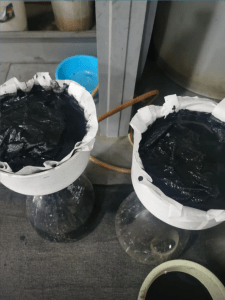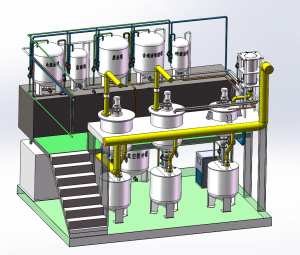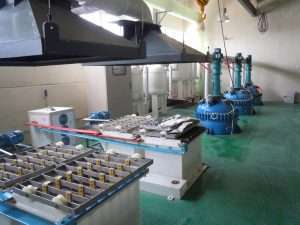Call us now:
About silver electrolysis, I believe that many people do not know very well, today I will come to introduce you in detail, hurry up and follow us to understand it.
Silver electrolytic refining theoretical basis:
Electrolytic refining of silver is to produce electrolytic silver of high purity. Through electrolysis can make the base metal impurities, gold and platinum group metals in the anode plate of crude silver separated. In the process of silver electrolysis, nitric acid and silver nitrate are used as medium, silver anode plate is used as anode and titanium plate is used as cathode, and direct current is passed to electrolysis, the main reactions occurring are
Anodic reaction: Ag-e Ag+; cathodic reaction: Ag+ + e Ag
In the process of silver electrolysis, according to the different nature and behavior of various elements contained in the silver anode, it can be divided into.
(1) metal ions whose electrical properties are more negative than silver, such as zinc, iron, tin, lead, arsenic, etc. The content of zinc, iron and arsenic is very small and has little effect on the electrolysis process; tin becomes stannate and enters the anode mud; lead enters the solution in part and is oxidized in part to produce PbO2 and enters the anode mud, while the few PbO2 adheres to the surface of the anode plate, which affects the dissolution of silver in the anode to a certain extent.
(2) Gold and platinum group metals which are electrically more positive than silver. These metals generally do not dissolve and enter the anode slime. When their content is very high, they will stay on the surface of the anode and hinder the dissolution of silver in the anode, even cause passivation of the anode and increase the anode potential, which affects the normal conduct of electrolysis. However, in actual production, some of the platinum and palladium enter the electrolyte, and when the electrolysis conditions are not controlled properly (too high electrolysis temperature and large current density), the amount of palladium and platinum entering the electrolyte will increase, and since the potential of palladium (0.82v) is similar to that of silver (0.8v), it may cause the palladium to precipitate at the cathode together with silver, thus affecting the quality of silver powder.
(3) Compounds that do not undergo electrochemical reaction, such as:Ag2Se, Ag2Te, Cu2Se, etc., will enter the anode slime because their electrochemical properties are very small and do not change during electrolysis, but when there is metallic selenium in the anode slime, it can be dissolved together with silver and precipitated on the cathode in a weak acidic electrolyte. However, in high acidity (about 1.5%) solution, the selenium in the anode does not enter the solution.
(4) Copper, bismuth and antimony, whose potentials are close to that of silver. These metals are harmful to electrolysis. Bismuth in the electrolysis process, part of the generation of alkali salt into the anode mud, another part of the bismuth nitrate into the solution, antimony and bismuth behavior is similar, antimony, bismuth in the solution after the accumulation of the cathode will be precipitated, affecting the quality of silver powder. When electrolyzed under low acid conditions, bismuth nitrate will hydrolyze to produce alkali salt precipitate, which affects the quality of silver powder. The copper content in the anode is high, but in the normal production process copper generally does not precipitate on the cathode, but when the electrolyte stirring cycle is poor, the concentration of silver ions in the electrolyte drops sharply, and the ratio of silver to copper content is less than 2:1, copper will partially precipitate on the cathode. And during the movement of copper ions in the solution to the cathode, Cu2+ may be reduced to Cu+, which in turn is oxidized to Cu2+ at the anode and consumes the power. Especially when the anode with high copper content is electrolyzed, since the cathode can only precipitate silver, and for every 1g of copper dissolved in the anode, the cathode will precipitate 3.4g of silver accordingly, which will easily cause the concentration of silver ions in the electrolyte to drop sharply. This is the risk of copper precipitation at the cathode. Therefore, when electrolyzing anode with high copper content, the electrolyte with high copper content should be extracted from the electrolyte and replenished with high concentration of silver nitrate solution, but it is also beneficial to maintain a certain concentration of copper in the electrolysis process, because copper can increase the density of the electrolyte and reduce the settling speed of silver ions.
The factors affecting the quality of silver powder during silver electrolysis are as follows.
(1) The content of impurities in the silver anode plate is unstable, such as: bismuth, copper, antimony, selenium and other elements in excess of the standard, will be precipitated with silver in the cathode under certain reaction conditions, affecting the quality of silver powder while consuming electricity; and lead, platinum, palladium and other metals in excess of the standard, may also consume electricity while affecting the precipitation of silver;
(2) Due to the limitations of the production equipment, some parts of the actual production process may affect the quality of the product;
(3) In the production process of this process, manual operation is used in many places, if the operation is not proper, it will also affect the quality of the product.
Improvement measures.
(1) Control the quality of anode plate;
(2) Strengthen the management of tank surface and eliminate irregular operations;
(3) Improve the operation procedure and improve the operation equipment.
The above is all about silver electrolysis, hope it can help you, if you need or have other content you want to know, welcome to leave a message to consult!


